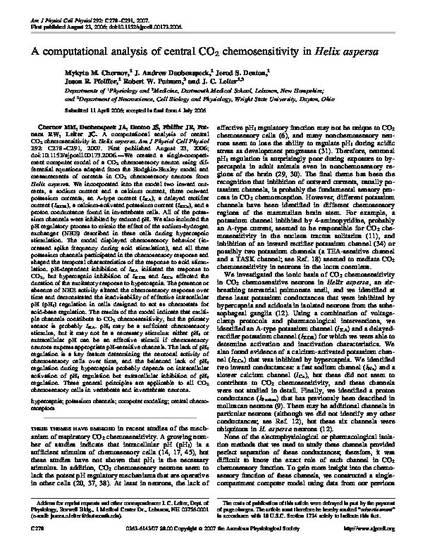
We created a single-compartment computer model of a CO2 chemosensory neuron using differential equations adapted from the Hodgkin-Huxley model and measurements of currents in CO2 chemosensory neurons from Helix aspersa. We incorporated into the model two inward currents, a sodium current and a calcium current, three outward potassium currents, an A-type current (IKA), a delayed rectifier current (IKDR), a calcium-activated potassium current (IKCa), and a proton conductance found in invertebrate cells. All of the potassium channels were inhibited by reduced pH. We also included the pH regulatory process to mimic the effect of the sodium-hydrogen exchanger (NHE) described in these cells during hypercapnic stimulation. The model displayed chemosensory behavior (increased spike frequency during acid stimulation), and all three potassium channels participated in the chemosensory response and shaped the temporal characteristics of the response to acid stimulation. pH-dependent inhibition ofIKA initiated the response to CO2, but hypercapnic inhibition of IKDR and IKCaaffected the duration of the excitatory response to hypercapnia. The presence or absence of NHE activity altered the chemosensory response over time and demonstrated the inadvisability of effective intracellular pH (pHi) regulation in cells designed to act as chemostats for acid-base regulation. The results of the model indicate that multiple channels contribute to CO2 chemosensitivity, but the primary sensor is probably IKA. pHi may be a sufficient chemosensory stimulus, but it may not be a necessary stimulus: either pHi or extracellular pH can be an effective stimuli if chemosensory neurons express appropriate pH-sensitive channels. The lack of pHi regulation is a key feature determining the neuronal activity of chemosensory cells over time, and the balanced lack of pHi regulation during hypercapnia probably depends on intracellular activation of pHi regulation but extracellular inhibition of pHi regulation. These general principles are applicable to all CO2 chemosensory cells in vertebrate and invertebrate neurons.
Available at: http://works.bepress.com/robert_putnam/26/
